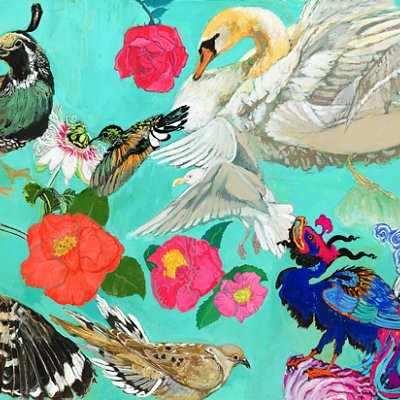Title: Conference of the Birds
Gallery:
My Inner Garden
View Larger/Proportional Image(s)
Gouache on paper (30 x 60)
Giclee available $3000
Conference of the Birds
July 2004, Myrtle Beach, South Carolina
A group of birds led by Hoopoe set out to find the mythical Bird of God: The Simurgh. "Many are called, but few are chosen." The birds I have portrayed are: Mountain Quail and California Quail, Hoopoe, Hummingbird, Mourning Dove, Swan and Seagulls, Simurgh, and Anhinga.
I have written in verse: "Language of the Birds - It Is All the Mirror of God" It is my own original adaptation of Farid ud-Din 'Attarâ's: Conference of the Birds.
I worked from C.S. Notts' wonderful rendering into English from Garcin de Tassy's translation of the Persian into French prose.
Excerpted from "Language of the Birds-It Is All the Mirror of God"
by Laurie Blum:
The tale of this book is a conversation
That took place in the beginning between all birds of creation.
They called a conference to find a king for their nation.
While they conversed concerning that quest,
The Hoopoe did speak, most Self-possessed:
"O My Brother and Sister Birds,
Above all birds in creation, I should be heard!
On the crest of my head, truth's golden crown sits,
With a cluster of fiery feathers, white-and black-tipped.
Like a warrior with striped wings, an armored cape to befit
A mighty conqueror of knowledge of light-and-dark's secret,
I am one who is engaged in divine warfare.
Of the world invisible, I am the messenger rare.
I carry knowledge of God and secrets of creation to share.
Bearing the name of God's mark on my beak,
Which holds the knowledge of hidden things sweet,
Still, I am restless and concerned with none,
Save my love for the True King and revealing His Kingdom.
Unapproachable is His dwelling place, high on a mountain.
In His Abode, no tongue His Name can mention.
He is close to us, but we are far from Him,
So my brothers and sisters, hear what I tell!
There's one King of the Birds and I know Him well,
But, alone, I cannot return where He dwells.
Abandon your faint-heartedness, self-conceit and dread!
Make light of your life and your false self you'll shed,
Along with all light and darkness, in the way of the Beloved.
I alone can guide you to Simurgh's realm, aloft,
Behind the mountains that surround the world, to a blissful paradise called Qaf."
Hoopoe speaks with impassioned words:
"He is Simurgh, King of the Birds.
Before Him hang a hundred thousand veils,
Sheathes of light and darkness, each a curtain to disentail.
The sovereign lord is He, bathed in perfection of His majesty,
Even in His dwelling place, He never manifests completely.
No knowledge or intelligence can understand this mystery.
Thousands of creatures spend their lives in longing
For this unknown Way, with no resolve or calling.
Indescribable is His beauty by even the purest soul,
So how can men of understanding of his invisible beauty be told?
The mind, His beauty, can neither fathom nor behold,
These two eyes are blind; they depend on reason's explanation,
Just as the parrot listens and mimics conversation.
Learn to see without eyes, and hear without ears,
And speak without tongue, to experience the inner spheres.
All creatures strive with their imagination
To perceive His beauty and to attain His Perfection;
How can that path be trod with thought?
To traverse land and sea, action is sought.
Cleansing the heart of the lover requires more than just reflection.
The perilous journey over treacherous terrain is vital for salvation.
Renounce this dear life for your Beloved, as worthy ones do,
And if you submit with grace, He will give His Life for you."
Farid ud-Din Attar, who was born possibly around 1136, was a great and an original poet who produced numerous religious and didactic works. He was essentially a mystic, and as such exercised a great influence on Rumi. The best known of his works, the Mantiq ut-Tair (translated by Fitzgerald as the Bird Parliament) , is a mystical allegory in which the birds all set off in search of the mythical Simorgh, whom they wish to make their king. The story, which symbolizes the quest of the soul for union with God, ends with their discovery that they have no existence separate from the object of their search.
The Simorgh then addresses them thus:
Pilgrim, Pilgrimage and Road
Was but Myself toward Mvself, and Your
Arrival but Myself at my own Door.....
Come, you lost Atoms, to your Center draw
And be the Eternal Mirror that you saw:
Rays that have wandered into Darkness wide
Return, and back into your Sun subside.




